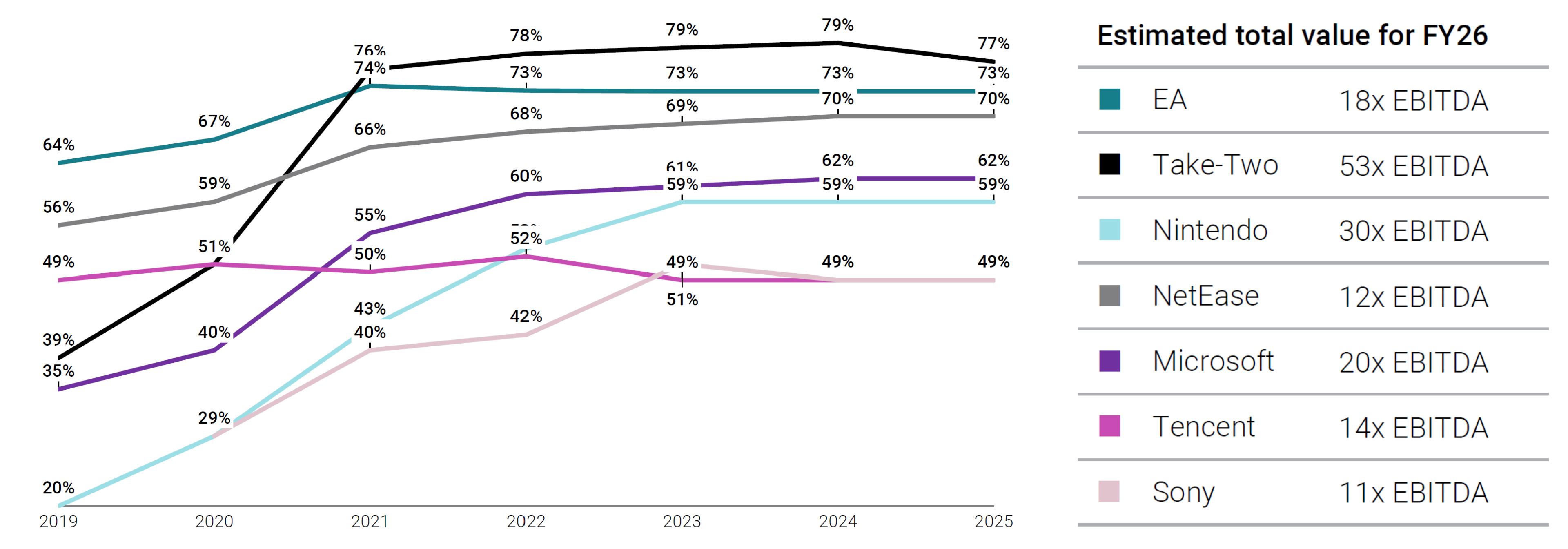By the end of 2026, gaming companies that successfully integrate AI into strong IP will command valuation multiples 2-3x higher than AI-laggard peers—a bifurcation driven by deeper engagement and higher average revenue per user.
The video gaming industry has grown into a $273 billion global market in 2024 and is projected to reach $656 billion by 2033. Yet valuing studios remains unusually difficult. While a single successful title can return 1,000%+ on investment, most games fail to break even—creating asymmetric risk-reward profiles that defy conventional valuation frameworks.
AI is now reshaping these valuation dynamics, transforming player engagement, content generation, and monetization. Leading studios are deploying AI not only as a cost-saving tool, but as a revenue engine that personalizes experiences, extends player life cycles, and unlocks new commercial opportunities within live-service environments. AI-driven player engagement measures are already producing ARPU lifts (180%+ in early implementations like OfferFit) and meaningful revenue growth (Tencent attributed 15% YoY gains partly to sustained investments and focus in AI). As investor focus shifts from traditional IP strength alone to IP amplified by AI-driven revenue capabilities, the gap between leaders and laggards is widening and will soon become insurmountable.
Key themes
Established studio valuations and AI adoption
Major gaming publishers are increasingly valued for their ability to monetize IP through AI-enhanced engagement rather than franchise strength alone. Take-Two, for example, sees AI-driven systems in GTA Online generating billions in incremental lifetime value. Market data shows diversified publishers with live-service and AI capabilities trade at 13–15x forward EBITDA versus 8–10x for traditional studios. M&A activity reflects this focus, with capital flowing to high-performing, AI-enabled assets like Miniclip and Keywords Studios. AI deepens engagement, boosts recurring monetization, and is now a key factor in premium valuation, widening the gap between legacy content houses and AI-first publishers.
Live-service/in-game content revenue (as % of total revenue)

Startups and the AI advantage
AI-focused gaming startups are commanding valuation premiums in early-stage markets. Analysis of 130 venture-backed companies found AI-enabled firms raised first-round valuations ~2.5x higher than non-AI peers. Startups like Backflip AI, Cartwheel, and Encultured AI leverage AI for content generation, AI-driven characters, and creator platforms to drive player engagement and revenue. Despite representing only 16% of startups with disclosed valuations, investor interest indicates early differentiation for AI-native models targeting measurable revenue gains. We predict a far greater percentage of companies with disclosed valuations will be AI-focused as of this time next year.
The new “battle royale” in video games
By 2026, studios combining durable IP with advanced AI can earn 2–3x valuation premiums. Revenue-driven outcomes—higher ARPU, deeper engagement, faster monetization—outweigh cost efficiency, though procedural automation remains important for gameplay quality. Executives are advised to prioritize player-facing AI features, such as adaptive challenges and credible NPCs, while using quieter AI applications for procedural generation, localization, and dialogue support. Continuous monitoring of player sentiment and in-game KPIs ensures AI improvements enhance engagement without alienating audiences, reinforcing long-term value and positioning studios on the favorable side of the AI-driven valuation divide.
2026 Media & Entertainment Industry Predictions Report
The media and entertainment world is shifting faster than ever—from streaming platforms merging short-form, long-form, and live content, to AI upending search and gaming, and M&A activity reshaping the landscape. Our annual Predictions Report dives into these trends, exploring who’s leading the charge, what’s next, and how businesses can stay ahead in a market defined by change. Click through to see where the industry is headed—and where opportunity lies.






